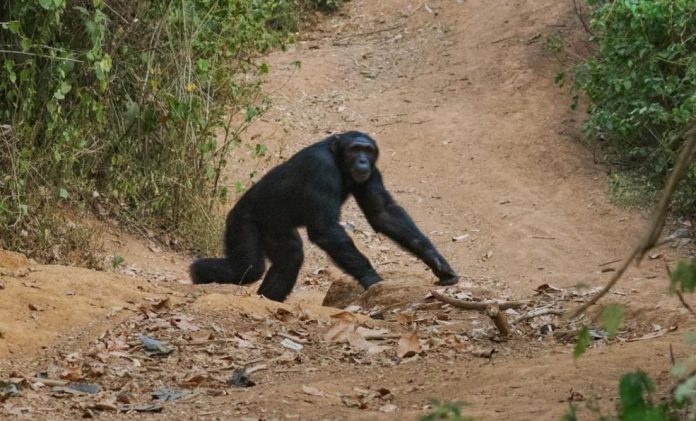A new and always fatal disease that has been killing chimpanzees at a sanctuary in Sierra Leone for years has been reported for the first time by an international team of scientists led by researchers at the University of Wisconsin-Madison.
The disease, reported Wednesday in the journal Nature Communications, is caused by a newly discovered species of bacterium and comes as the world wrestles with a devastating pandemic caused by another novel foe, the new coronavirus.
Although the chimpanzee illness has yet to be found in a human being, the two species share about 99% of their hereditary material, or DNA.
“There are very few pathogens that infect chimpanzees without infecting humans and very few pathogens that infect humans without infecting chimpanzees,” said Tony Goldberg, one of the authors of the paper and a University of Wisconsin-Madison professor of epidemiology.
Lethal diseases, including Ebola and HIV, have jumped from great apes to humans. Other diseases, such as influenza and polio, have gone the opposite route, passing from humans to apes.
Diseases with 100% fatality rates are very rare. Ebola, one of the most-feared illnesses in humans, kills about 50% of those infected.
“The staff at Tacugama (Sanctuary in Freetown, Sierra Leone) are super worried. It looks like something we need to be concerned about,” Goldberg said.
The new bacterium is called Sarcina troglodytae; the newly described disease it causes has been named Epizootic Neurologic and Gastroenteric Syndrome, or ENGS.
ENGS first appeared around 2005 and strikes its victims suddenly. A chimpanzee that had looked healthy just a day earlier contracts the disease and stumbles around almost drunkenly with a nervous system disorder known as ataxia. The chimpanzees also suffer bloating of the stomach and the intestines. They appear to die from gas that gets into the tissue of the intestines.
Kirsten Gilardi, director of the Karen C. Drayer Wildlife Health Center at the University of California, Davis, was not involved in the new study but called it “a comprehensive and elegant disease investigation.” She stressed that researchers used a variety of scientific tools, including whole genome sequencing, “to solve a mystery that has puzzled all of us in the great ape health world for many years.”
Gilardi was intrigued by the authors’ suggestion “that reports in the scientific literature of illness in animals and people caused by this pathogen have increased over the last decades — and by their suggestion that this may be related to climate change and shifting environmental conditions.”
Sharon Deem, director of the Institute for Conservation Medicine at the Saint Louis Zoo, said, “They did a very sound study. I think they did a great job on the epidemiology all the way up to the new genomic techniques.”
Deem stressed that the new work raises fascinating questions that require further study: Is the disease caused by other factors in addition to the bacterium? And why is there a high prevalence of the disease in the month of March?
All great apes, including chimpanzees, eastern and western gorillas, orangutans and bonobos are either endangered or critically endangered. Over the years they have been losing their forest habitats to human activities such as agriculture, mining and commercial logging.
The sanctuary in Sierra Leone is home to western chimpanzees, a species whose population is estimated to be around 52,800, according to the Wildlife Conservation Society. Most of the chimpanzees at the sanctuary have been rescued from the pet or bush meat trade.
Work on the new disease proved to be a massive undertaking for Goldberg and collaborators from Sierra Leone, Germany, Italy, the United Kingdom and the Biological Defense Research Directorate at Fort Detrick, Maryland.
“It took years just to get the chimpanzee samples out of Sierra Leone. We did this in the middle of the Ebola epidemic,” Goldberg said. “I would never in a million years have predicted how complicated this project would be.”
During the Ebola epidemic it was especially difficult to acquire the permits needed from the government of Sierra Leone to take infected chimpanzee tissue out of the country, and from the U.S. Fish and Wildlife Service to bring that tissue into the U.S. for study.
For about two years, the samples — including organs, blood, stool and stomach contents — had to remain in a minus 80 degrees Celsius freezer in Sierra Leone.
Goldberg, one of Wisconsin’s leading disease hunters, worked extensively with a student, Leah A. Owens, who is studying to receive both a doctorate in veterinary medicine and a Ph.D. The two traveled to Sierra Leone in 2019 and spent several weeks there.
Goldberg is perhaps best-known in Wisconsin for a paper he authored in 2014 solving the mystery of what killed the Milwaukee County Zoo’s popular orangutan, Mahal. The culprit was a new species of tapeworm.
In 2012, Goldberg also made headlines when he discovered a new species of tick — in his nostril. Although he made that discovery in his Madison home, he had just returned from Uganda where he almost certainly acquired the tick.





























